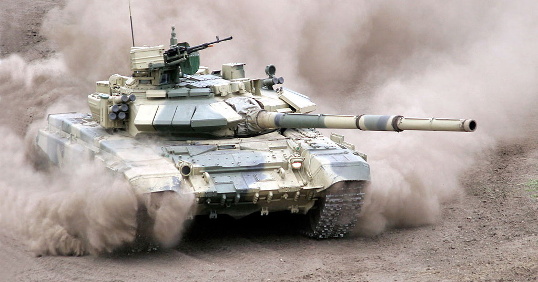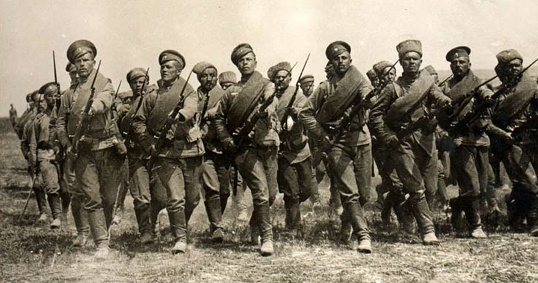1 June 25, 2025
Articles
1. Svetlana V. Petrova, Nikolai A. Ivanov, Semyon N. Gonta
The Combat Path of Some Distinguished Fighters of the Sukhumi (41st Separate Rifle) Division of the Internal Troops of the NKVD of the USSR
Voennyi Sbornik. 2025. 13(1): 4-12.
Number of views: 73 Download in PDF
2. Konstantin V. TaranVoennyi Sbornik. 2025. 13(1): 4-12.
Abstract:
This article is devoted to the study of the combat path of some distinguished fighters of the Sukhumi (41st separate rifle) division of the internal troops of the NKVD of the USSR, who were noted by the division commander in his characteristics of the unit. As research materials, this work uses various documents of the Central Archive of the Ministry of Defense of the Russian Federation, as well as the Russian State Military Archive. The research methodology is presented by both general scientific and special historical research methods. The article attempts to restore the combat path of the fighters and perpetuate historical memory. The authors managed to establish the stages of the combat path of 7 out of 12 noted fighters (place of birth, age, conscription into the army, combat awards and other data). In conclusion, the authors draw conclusions about the contribution of the noted fighters to the combat path of the Sukhumi division, separately noting the manifestations of heroism of female soldiers.
This article is devoted to the study of the combat path of some distinguished fighters of the Sukhumi (41st separate rifle) division of the internal troops of the NKVD of the USSR, who were noted by the division commander in his characteristics of the unit. As research materials, this work uses various documents of the Central Archive of the Ministry of Defense of the Russian Federation, as well as the Russian State Military Archive. The research methodology is presented by both general scientific and special historical research methods. The article attempts to restore the combat path of the fighters and perpetuate historical memory. The authors managed to establish the stages of the combat path of 7 out of 12 noted fighters (place of birth, age, conscription into the army, combat awards and other data). In conclusion, the authors draw conclusions about the contribution of the noted fighters to the combat path of the Sukhumi division, separately noting the manifestations of heroism of female soldiers.
Number of views: 73 Download in PDF
To the Issue of the Fighting of Soviet and German Troops on the Kuban River (August 3-7, 1942)
Voennyi Sbornik. 2025. 13(1): 13-25.
Number of views: 71 Download in PDF
3. Nicholas W. Mitiukov, Yurii L. KimVoennyi Sbornik. 2025. 13(1): 13-25.
Abstract:
This article examines the fighting of Soviet and German troops on the Kuban River in the period from 3 to 7 August 1942 on three bridgeheads: Kropotkin – Temizhbekskaya, Novo- Mikhailovskoye – Grigoripolisskaya and Krasnaya Polyana – Prokhnookopskaya. The documents of the Central Archive of the Ministry of Defense of the Russian Federation (Podolsk, Russian Federation), posted on the portal “Memory of the People”, as well as materials published in collections of documents, were used as sources. In addition, research by Soviet, Russian and foreign authors was used. In conclusion, the author comes to the conclusion that the command of the North Caucasian Front could not cope with the task set by the Supreme Command Headquarters. Despite the resistance of the Soviet troops, the Wehrmacht troops crossed the Kuban River, created two bridgeheads on the left bank of the Kuban River in the area of Novo-Mikhailovsky and Krasnaya Polyana, as well as a bridgehead in the Kropotkin – Temizhbekskaya area, which was auxiliary. During the fighting from August 3-7, 1942, the Soviet troops of the North Caucasian Front unsuccessfully tried to destroy the Wehrmacht troops on these bridgeheads, which on August 5 broke through the defenses of the 1st Separate Rifle Corps from Krasnaya Polyana and launched an offensive in a westerly direction in order to encircle and destroy the troops of the North Caucasian Front.
This article examines the fighting of Soviet and German troops on the Kuban River in the period from 3 to 7 August 1942 on three bridgeheads: Kropotkin – Temizhbekskaya, Novo- Mikhailovskoye – Grigoripolisskaya and Krasnaya Polyana – Prokhnookopskaya. The documents of the Central Archive of the Ministry of Defense of the Russian Federation (Podolsk, Russian Federation), posted on the portal “Memory of the People”, as well as materials published in collections of documents, were used as sources. In addition, research by Soviet, Russian and foreign authors was used. In conclusion, the author comes to the conclusion that the command of the North Caucasian Front could not cope with the task set by the Supreme Command Headquarters. Despite the resistance of the Soviet troops, the Wehrmacht troops crossed the Kuban River, created two bridgeheads on the left bank of the Kuban River in the area of Novo-Mikhailovsky and Krasnaya Polyana, as well as a bridgehead in the Kropotkin – Temizhbekskaya area, which was auxiliary. During the fighting from August 3-7, 1942, the Soviet troops of the North Caucasian Front unsuccessfully tried to destroy the Wehrmacht troops on these bridgeheads, which on August 5 broke through the defenses of the 1st Separate Rifle Corps from Krasnaya Polyana and launched an offensive in a westerly direction in order to encircle and destroy the troops of the North Caucasian Front.
Number of views: 71 Download in PDF
Boats of the Sarapul Roadstead of the Kamlesosplav Trust, Which Worked in Sarapul during the War
Voennyi Sbornik. 2025. 13(1): 26-37.
Number of views: 65 Download in PDF
4. Semyon N. GontaVoennyi Sbornik. 2025. 13(1): 26-37.
Abstract:
There was reconstruction of the biographies of the vessels that worked at the Sarapul roadstead of the Kamlesosplav trust during the war is made. A total of five boats were considered: No. 17, No. 33, No. 40, No. 54 and “Pioner”. Boats No. 70, No. 89 and “Kolkhoznitsa” were not considered as they were listed in Sarapul for a short time. Boat No. 58 was also not considered as it was received after the war. The materials used for the reconstruction were orders on the main activities of the Kamlesosplav trust, documentation on the main activities, orders on personnel and statistical reports of the Sarapul roadstead. The conclusions obtained during the work for the Sarapul roadstead can be expanded to the entire Kamlesosplav trust. Thus, as a result of the study, it was established that none of the boats were mobilized, which is explained by the important strategic task of the trust to supply timber to the lower reaches of the Volga. The trust itself and the leadership of the People's Commissariat of the Forestry Industry constantly carried out a castling of the fleet for better use of the available resources. In the most difficult year for the trust in 1942, boats were transferred to it from other trusts, and in 1944 it itself transferred boats to the farms of the liberated regions. During the war, the trust steadily carried out work to transfer the boats to solid fuel. This increased the resilience of the fleet to interruptions in the supply of liquid fuel, but at the same time, it made the maintenance of the ships more difficult, in particular, an additional person was introduced into the team – a shurovischik. During the war, this played a role, and after the Victory, a reverse modernization of the ships took place.
There was reconstruction of the biographies of the vessels that worked at the Sarapul roadstead of the Kamlesosplav trust during the war is made. A total of five boats were considered: No. 17, No. 33, No. 40, No. 54 and “Pioner”. Boats No. 70, No. 89 and “Kolkhoznitsa” were not considered as they were listed in Sarapul for a short time. Boat No. 58 was also not considered as it was received after the war. The materials used for the reconstruction were orders on the main activities of the Kamlesosplav trust, documentation on the main activities, orders on personnel and statistical reports of the Sarapul roadstead. The conclusions obtained during the work for the Sarapul roadstead can be expanded to the entire Kamlesosplav trust. Thus, as a result of the study, it was established that none of the boats were mobilized, which is explained by the important strategic task of the trust to supply timber to the lower reaches of the Volga. The trust itself and the leadership of the People's Commissariat of the Forestry Industry constantly carried out a castling of the fleet for better use of the available resources. In the most difficult year for the trust in 1942, boats were transferred to it from other trusts, and in 1944 it itself transferred boats to the farms of the liberated regions. During the war, the trust steadily carried out work to transfer the boats to solid fuel. This increased the resilience of the fleet to interruptions in the supply of liquid fuel, but at the same time, it made the maintenance of the ships more difficult, in particular, an additional person was introduced into the team – a shurovischik. During the war, this played a role, and after the Victory, a reverse modernization of the ships took place.
Number of views: 65 Download in PDF
Rhodesian Security Forces against Guerillas (1965–1979): Main Weapons and Equipment of the Sides
Voennyi Sbornik. 2025. 13(1): 38-54.
Number of views: 67 Download in PDF
5. Voennyi Sbornik. 2025. 13(1): 38-54.
Abstract:
This article is devoted to the study of weapons and military equipment of both sides of the bush war (1965–1979). In this first part of the work, the author examines small arms and military equipment of the Rhodesian Security Forces. Numerous photographs of that time and illustrations are used as research materials. The research methodology is represented by both general scientific and special historical research methods. The article is divided into 4 thematic sections (“Small arms and light weapon systems of the army and police”, “Light vehicles of the army and police”, “Armored military vehicles” and “Aviation of the Rhodesian Air Force”), in each of which small arms are analyzed, as well as military equipment. In conclusion, the author draws conclusions about the specific position of the Rhodesian Security Forces in the field of provision of weapons and equipment, as well as the further use of the experience of the Rhodesian war in the creation of MRAP-type vehicles.
This article is devoted to the study of weapons and military equipment of both sides of the bush war (1965–1979). In this first part of the work, the author examines small arms and military equipment of the Rhodesian Security Forces. Numerous photographs of that time and illustrations are used as research materials. The research methodology is represented by both general scientific and special historical research methods. The article is divided into 4 thematic sections (“Small arms and light weapon systems of the army and police”, “Light vehicles of the army and police”, “Armored military vehicles” and “Aviation of the Rhodesian Air Force”), in each of which small arms are analyzed, as well as military equipment. In conclusion, the author draws conclusions about the specific position of the Rhodesian Security Forces in the field of provision of weapons and equipment, as well as the further use of the experience of the Rhodesian war in the creation of MRAP-type vehicles.
Number of views: 67 Download in PDF






